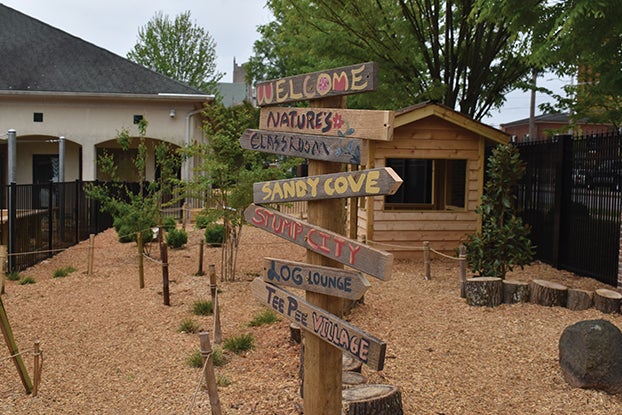A place to explore and discover: St. John’s opens new outdoor learning environment
Published 12:00 am Sunday, April 25, 2021

- Lelonna Richardson shows off one of the water play stations in the OLE. Ben Stansell/Salisbury Post
SALISBURY — When the children at St. John’s Lutheran Church’s Child Development Center stepped out of their classrooms and into the new outdoor learning environment for the first time, they weren’t sure how to react.
“I don’t think, at first, they knew exactly what they walked into,” said Lelonna Richardson, program coordinator for the Child Development Center.
The outdoor area, with mulched pathways, grassy green spaces and intermittent gardens, is completely different from the traditional playground equipment that was there before. But the children’s’ confusion didn’t last long. Soon, they were dipping their hands in wooden boxes filled with water, slapping together mud cakes in small roofed kitchens and diving into sand boxes.
“It was amazing to see how quickly they figured it out,” Richardson said. “They started teaching us how to use it.”
Based on a design composed by N.C. State’s Natural Learning Initiative, the outdoor learning environment was the Child Development Center’s answer to needing to replace its “tired” playground of 20 years. Instead of removing the old equipment and putting a new version in its place, the center’s leaders decided to go a different direction by creating a more natural landscape devoid of swings or slides.
“Research shows that this is what’s best for the children, so we wanted to create the best environment for them,” Richardson said.
Outdoor learning environments are “designed to promote health by increasing physical activity, healthy eating, and positive social interactions. Exposure to nature has many beneficial effects, including boosting young immune systems and protecting children from onset of allergies,” according to N.C. State’s Natural Learning Initiative.
Although the outdoor learning environment opened to students and teachers in February, an official ribbon cutting ceremony and dedication will be held today at the Child Development Center at 2 p.m. The ceremony will give parents a chance to see the OLE for the first time. Representatives from N.C. State’s Natural Learning Initiative will be in attendance. Tours of the outdoor learning environment, which features a teepee village, a circle of stumps perfect for story time and several stages on which children can act out their imagination, will be provided.

Children have plenty of options on how and where to spend their time in the outdoor learning environment. Ben Stansell/Salisbury Post
Amy Ritchie, a member of the Child Development Center’s Advisory Committee, said it will be a place for children to explore and discover.
St. John’s Child Development Center has an enrollment of 144 children, from 6 weeks to 4 years old. The outdoor learning environment is split into three separate areas, one for infants, one for toddlers and one for preschoolers.
The plans for the outdoor area were drawn up in 2019; the next several months were spent fundraising. Demolition and construction started in June. Colleen McDaniel, a landscaper and owner of The Inspired Garden in Badin, was charged with bringing designs for the outdoor environment to life. Ritchie said St. John’s was thrilled with her work. McDaniel implemented similar outdoor environments at the Charlotte Nature Museum and Wing Haven.
While the outdoor environment was being installed, six members of the Child Development Center’s staff took classes on how they could use the new, dynamic outdoor environment as a teaching tool. Like the children, they too had to learn how to use the space.
“We went through training and got certified,” Richardson said. “We first got to see the pictures and learn but now it’s been more hands on because you can see it in real life.”
As opposed to a playground, the outdoor learning environment gives children more opportunities to explore their senses while also learning valuable lessons about environmental stewardship. Herbs, fruits, vegetables and flowers are all growing, allowing the children an opportunity to learn how to care for plants.
“We’re going to teach the students where the food comes from, then we’re going to try the food and we’re going to do a whole process and make graphs with them to show when they plant the seeds how they grow and chart out who likes which vegetables,” Richardson said.
Nothing planted in the outdoor learning environment, Richardson said, is harmful in any way.

The outdoor learning environment replaces playground equipment with a natural landscape that gives children an opportunity to explore their senses. Ben Stansell/Salisbury Post
The outdoor area is viewed by the center’s staff as more than just a place to take the children to play; it’s seen as an extension of the classroom. Richardson said staff have already started teaching some lessons outside under one of the several wooden pergolas.
“They think they’re playing, but they don’t realize that they’re learning the whole time,” Ritchie said. “Learning doesn’t stop when you come outside.”
Ritchie said she believes that the outdoor area will become a model for other pre-K and early education centers throughout the region.



